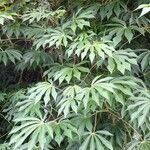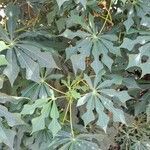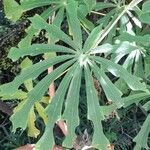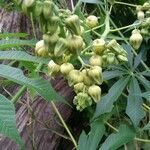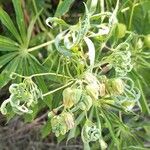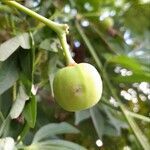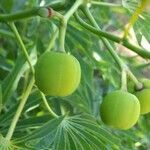A large glabrous woody herb or subshrub up to 2.5 m. tall.. Young shoots glaucous greenish brown, sometimes suffused purplish.. Leaves deeply palmatipartite, with (5–)7–11(–13) lobes, shallowly cordate, membranaceous to chartaceous, the lobes oblong-oblanceolate, occasionally subpanduriform, 6–14 cm. long, 1–3.5 cm. wide, acutely long-acuminate, attenuate towards the base, confluent into a basal disc 1–1.8 cm. wide, entire, with up to 20 pairs of lateral nerves, midrib not prominent above, prominent beneath; petiole 5–19 cm. long, with a small tuft of hairs at the apex.. Stipules setaceous, 1.5 cm. long, slightly laciniate towards the apex, readily deciduous.. Inflorescence racemose or subpaniculate, 10–15 cm. long; bracts linear-lanceolate, 5 mm. long, soon deciduous.. Male flowers: pedicels decurved, up to 1 cm. long, slender; calyx ovoid in bud, campanulate, the lobes imbricate, triangular-ovate, 1 cm. long, 5 mm. wide at the base, subacute, glabrous without and within, greenish yellow, each with 2 elongate purplish black blotches within, the tube 7–8 mm. long, also glabrous and greenish yellow; long filaments 7 mm. long, short filaments 3 mm. long, slender, glabrous, anthers 4 mm. long, narrow; disc 10-lobed, concave at the centre, the lobes rounded.. Female flowers: pedicels patent, 7 mm. long, extending to 2 cm. in fruit; calyx ± as in ♂ but with the sepals free almost to the base; disc pentagonal; ovary 2 mm. long, 2 mm. diameter, smooth; styles flabelliform, inrolled, 2 mm. long, with a tuberculate stigma.. Fruit subglobose, scarcely trilobed, 1.4 cm. long and 1.5 cm. wide when dried, smooth, tubercled-rugulose when dried, yellowish brown; endocarp woody.. Seeds dorsiventrally biconvex, elliptic-ovate in outline, 1.2 cm. long, 0.8 cm. wide, 4.5 mm. deep, buff-coloured, streaked and flecked with dark brown, shiny, with a caruncle 4 mm wide.
More
Shrubs or trees, 2–6[–7] m. Roots not thickened. Stems erect, angled when young; nodes not swollen; leaf and stipule scars not elevated. Leaves deciduous; stipules linear, remotely serrate; petiole 5–33 cm; blade basally attached, 5–13-lobed, median and adjacent lobes with pair of weakly defined rounded secondary lobes distal to middle, lateral lobes without secondary lobes, median lobe 5–24 cm, margins neither thickened nor revolute, entire, apex acuminate, surface glabrous, abaxial smooth. Inflorescences axillary, panicles, to 30 cm. Pedicels: staminate 4–10 mm; pistillate 10–40 mm in fruit, straight. Staminate flowers: calyx campanulate, 10–15 mm, lobes erect or spreading; stamens 10. Capsules 1.8 cm, smooth, not winged. Seeds oblong, 10–12 mm.
Subshrub or shrub to 4 m high. Root tubers absent. Stipules lanceolate, 9–15 mm long. Leaves deeply palmatipartite, 5–13 lobed, the lobes oblong to oblanceolate, 5–14 cm long, 0.9–3.5 cm wide; base attenuate; tip acuminate. Male flowers: pedicels 7–10 mm long; calyx lobes triangular-ovate, 4–10 mm long, 3–5 mm wide, tube 5–8 mm long. Female flowers: pedicels 7–9 mm long; calyx lobes triangular-ovate, 10–12 mm long, 5–5.5 mm wide, tube 1–3 mm long. Fruit subglobose, c. 14 mm long and 15 mm diam. Seeds ellipsoid, c. 12 mm long and 8 mm wide.
Very similar to M. esculenta, but differing in having the leaf blades 12–30 cm wide, 6–13-lobed, with the lobes narrowly oblanceolate-oblong and often subpanduriform, the median lobe 6.5–16 × 1–4 cm; the disk in both sexes bright orange; the fruits slightly larger (1.8 × 1.9 cm) and without wings; the seeds biconvex with a sharp lateral ridge.
